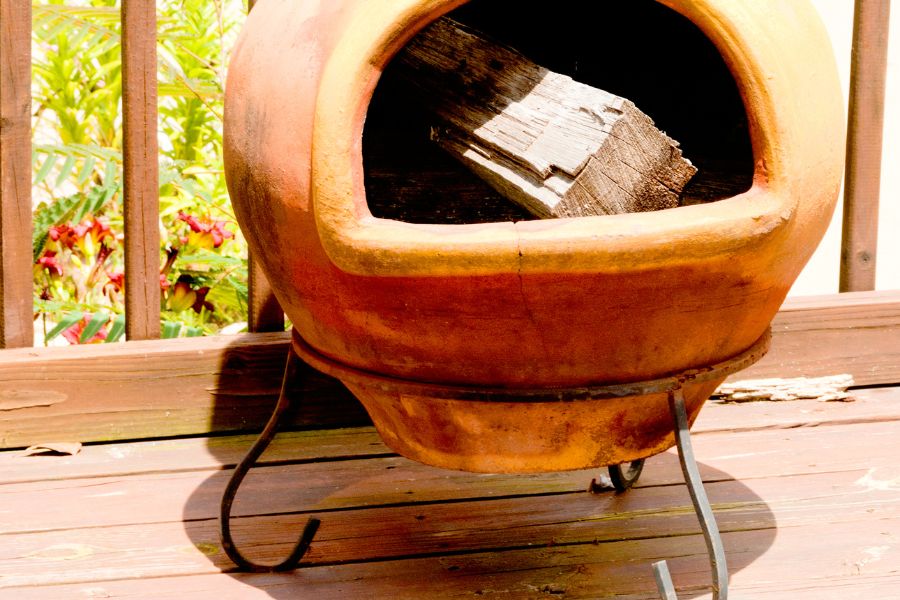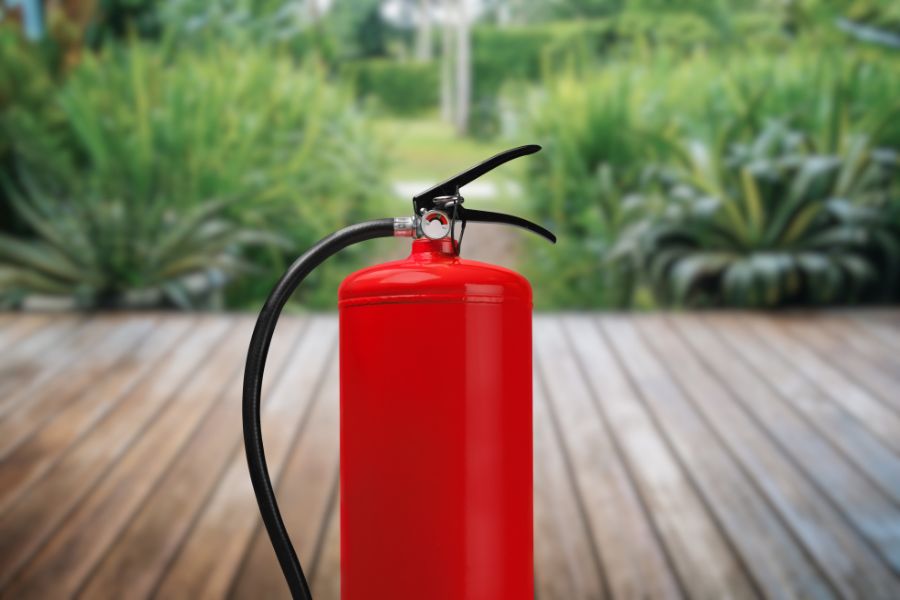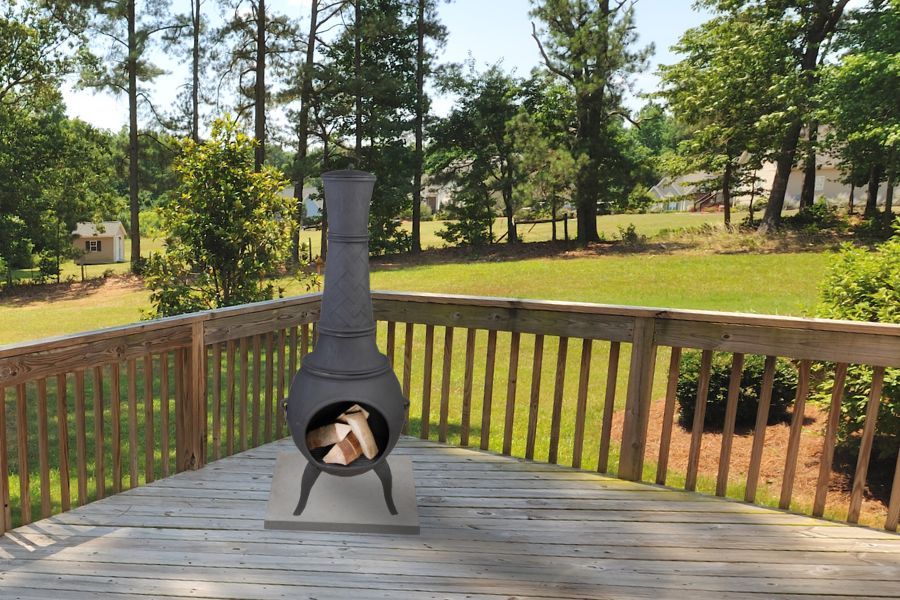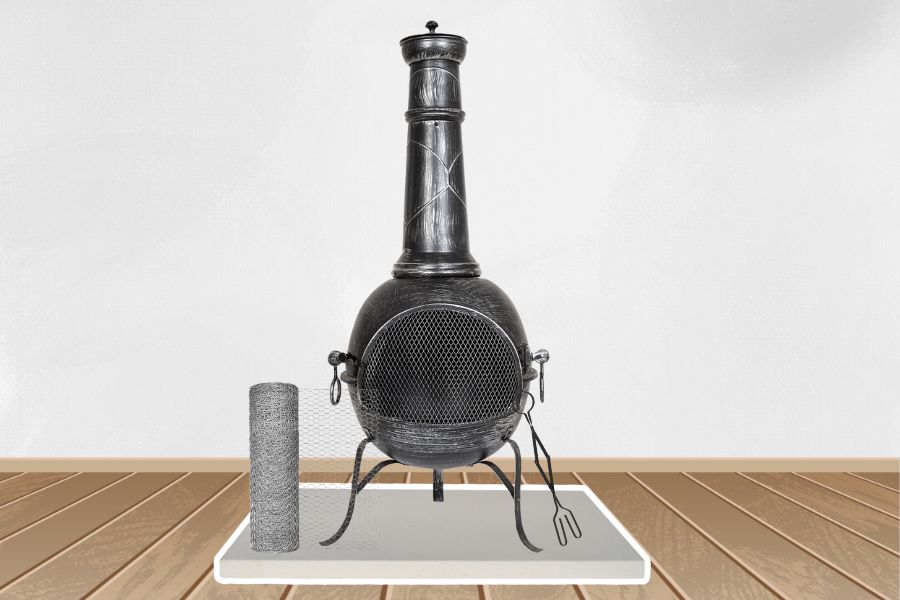A chiminea is a special kind of fireplace. Imagine a cozy fire from a chiminea on your wood or composite deck. Sounds great, right? But it’s important to know how to use them safely.
Understanding Chimineas: From Clay to Cast Iron
Chimineas! They’re fire pits with flair, perfect for an outdoor living space. You can put a chiminea on decking materials like wood or composite, but caution is key. They can witness a fire, and a chiminea fire can create a significant fire risk. That’s because they emit hot embers and flying sparks, which can ignite flammable materials nearby.
Now, chimineas come in two main types: clay and cast iron. Clay chimineas have a unique charm. They’re beautiful but can crack under extremely high temperatures.
On the other hand, cast iron chimineas are tough, handle heat well, and offer heat protection to the surrounding area.
But remember, placing your chiminea directly on a wooden or composite deck can be a fire hazard. You need a spark screen to prevent sparks and a chimney stack to guide smoke away. Safety comes first, always.
Evaluating the Fire Risk of a Chiminea on Wood Deck

Heat and Fire: The Impact on Wooden and Composite Decks
Chimineas are pretty cool, right? But they bring the heat. Both clay and cast iron chimineas emit a lot of it. Think about that heat when you put a chiminea on a wooden deck. You might be wondering why. It’s because wood is a combustible material. And composite decking? It’s not fireproof, either.
The heat and hot ash from the chiminea can harm your deck surface. It’s true for both wooden and composite decks. The heat can char your beautiful deck, and the burning ash can leave unsightly marks. But don’t worry!
Fire-resistant material is your friend here. A fire-safe platform can protect your deck from the heat. Fire-resistant materials like stone, metal, or even special mats can work.
Potential Fire Hazards: Overhanging Tree Branches and Flammable Objects
But heat and fire from your chiminea can do more than harm your deck. They can also be a risk to other things around your outdoor space.
Imagine having overhanging tree branches or flammable material near your chiminea. A stray spark could ignite them, creating a fire hazard.
And then there’s carbon monoxide. It’s a dangerous gas that chimineas emit. It’s not a risk for your deck, but it’s a risk for you and your loved ones. So, remember to use your chiminea safely.
Using a chiminea on a wooden deck or composite decking can be safe. You have to be careful and smart about it. Keep your chiminea away from overhanging branches and flammable items.
Use fire-resistant material to protect your deck. With these steps, you can enjoy your chiminea without worry.
Preparation: Ensuring a Safe Outdoor Fireplace Experience
The Importance of a Fire Extinguisher Nearby and Adequate Ventilation

When you’re ready to set up your chiminea, be it a clay or cast iron chiminea, on your wood deck, think safety first. Before lighting that first large fire, you must have two things nearby: a fire extinguisher and lots of fresh air.
Why the extinguisher? It’s your first defense if your chiminea starts to get out of hand. Remember, your wood decking can be a flammable surface. So can other flammable materials around your chiminea.
You don’t want to end up with a fire pit instead of a chiminea. Having an extinguisher nearby can prevent a small problem from becoming big.
Now, let’s talk about air. Your chiminea needs lots of it. Combustible materials like wood decks can release smoke when they get too hot.
And smoke isn’t good for you or the people around you. So, ensure plenty of ventilation where you set up your chiminea. A good breeze can carry away any smoke and keep the air fresh.
Proper Fuel and Radiant Heat Management for your Chiminea
The fuel you use in your chiminea matters. Don’t throw in any flammable items you find. Not all things burn the same way. Some things can burn too hot or fast, making your chiminea unsafe.
Choosing the right fuel is key. Hardwood is often the best choice. It burns at a stable rate and doesn’t cause extreme radiant heat.
Now, radiant heat. It’s the warmth you feel from your chiminea. But too much of it can cause problems. It can make your wood decking hot.
It can even melt a plastic surface. So, managing your chiminea’s heat is critical. And using the right fuel is a big part of that. Enjoy your chiminea safely!
Protecting Your Deck from Chiminea Heat
Fire Resistant Surfaces: From Brick Hearth to Concrete Pavers

Want to protect your deck from your chiminea’s heat? Try a fire-resistant surface. It could be a brick hearth or concrete pavers.
These surfaces can handle the heat from a fire pit or a clay chiminea. They won’t catch fire or get damaged. Place your chiminea on this surface, and your deck is safe.
Using Heat Shields and Spark Screens for Deck Protection
Heat shields and spark screens are also great. They help protect your deck from your chiminea’s heat and sparks. A heat shield goes under your deck boards your chiminea.
It blocks the heat from reaching your deck. It’s like a superhero for your deck, protecting it from the villainous heat.
A spark screen is another hero. It covers your chiminea’s opening. It catches any sparks that try to escape. No rogue sparks mean no surprise fires on your deck.
These two tools are your deck’s best friends when using your chiminea. Use them, and your deck’s surface will thank you.
Chiminea Placement and Safety Measures
How Much Space Is Required Around a Chiminea on a Wooden Deck?
Placing a chiminea on a wooden deck needs thought. You can’t just put it anywhere. It needs space. But how much?
Think about a circle. The chiminea is in the center. Around it, you need an open area. This area should be at least a few feet wide.
This space stops the heat from your chiminea, or even a fire pit, from reaching anything that could catch fire. It’s your safety zone.
Managing Flying Embers and Sparks: The Role of Chicken Wire and Other Tools
Sparks and embers can fly out of your chiminea. They’re small, but they can start big fires. You need to stop them. But how?
Chicken wire is one way. You can put it over your chiminea’s opening. It acts like a net, catching any flying sparks.
There are also tools for managing embers. A long pair of tongs can help you adjust the fuel in your chiminea. That way, you can stop any embers before they become a problem.
Remember, safety is key when using a chiminea. These steps can help you use yours safely.
Maintaining your Chiminea and Deck
Just like a fire pit, a chiminea needs regular checks. Look for burn marks on your deck. These can tell you if your chiminea is too hot or too close.
Also, touch your deck around the chiminea (but be careful!). If it feels too hot, your chiminea may be a risk.
Weather matters when you’re using a chiminea or fire pit. Dry weather can make your deck more flammable. If it’s been dry for a few days, be extra careful with your chiminea. Maybe use it less, or not at all.
Inclement weather is also a concern. Rain or wind can make using your chiminea unsafe. Rain can put out your chiminea suddenly.
That can cause smoke and steam, which aren’t good for you or your guests. Wind can blow sparks around, starting fires in places you don’t want.
So, keep an eye on the weather when you’re planning to use your chiminea. And always remember, safety first!






